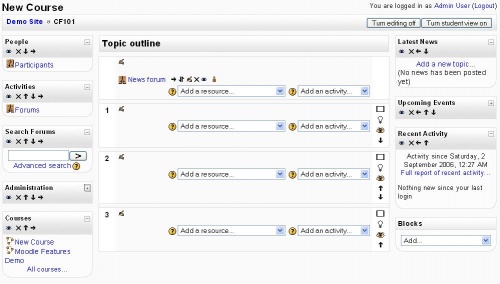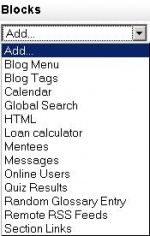Getting started for teachers
If you are a new user and would like a list of all teacher documentation articles, please see Category:Teacher.
We are assuming that your site administrator has set up Moodle, you are a user with teacher privileges and the administrator has assigned you to a new, blank course. Don't forget, demo.moodle.org will let you play an hour at a time for free.
You will need to be logged into the course as a user who has been assigned a role as a teacher (with editing rights) on that course to use most of the features below. We have some tips if you are having trouble logging in.
Now onto the real details. You will find the course homepage is broken down into course sections. A course is created by adding resources and activities. When writing text in Moodle you have a range of Formatting options, including using HTML in Moodle. There are different ways to enroll Students and assign them to one or more Groups in a course.
The example below shows a new course set up with topic sections, edit is on. There are a few of Moodle's many blocks on the right and left sides of the topics, such as "Latest News" or "Administration". The teacher is ready to add resources and activities or a few new blocks to their brand new course.
Editing course section
File:Turn edit on Student on buttons.JPG
To add or alter activities or resources a teacher will need to turn editing on and off with a button on the course homepage. The student view/change roles option allows the teacher to get a general idea of what students will see. There is also an "editing on" link in the administration block. The turn editing option toggles between on and off, and when on, shows a variety of editing icons next to all editable objects in the course. Here are some common editing icons, for more details about them go to adding/editing a course. To ADD items you must use the appropriate drop-downs for them.
* (Note that the open eye indicates that the resource is visible, while clicking it changes it to be invisible (to students), and vice versa with the closed eye. ** Note that the X deletes resources and activities (with a warning) whereas it only removes blocks (which can be added at any time later)
Activity modules
There are a number of robust interactive learning activity modules that you may add to your course with the "Add an activity" drop down menu.
Communication and collaboration may take place using live Chats or asynchronous discussion Forums for conversational activities. You can also use Choices to gain group feedback. Adding Wikis to your courses is an excellent way to allow students to work together on a collaboratively-authored project.
Work can be uploaded and submitted by students and scored by teachers using Assignments or Workshops. Workshops such as these have several assessment options, including instructor-assessment, self-assessment, and even peer-assessment. Online Quizzes offer several options for automatic and manual scoring. You can even integrate your Hot Potato quizzes by adding a Hotpot activity.
Lessons and SCORM activities deliver content and offer ways of individualizing your presentation based upon a student's choices. Glossaries of keywords can be set up by the instructor, and can be configured to allow students to edit, add, or rate entries.
Surveys and Databases are also very powerful additions to any course.
If all of that isn't enough for you then you can also add contributed modules that are not part of the official Moodle release!
Resources
Moodle supports a range of different resource types that allow you to include almost any kind of digital content into your courses. These can be added by using the add a resource dropdown box when editing is turned on.
A Text page is a simple page written using plain text. Text pages aren't pretty, but they're a good place to put some information or instructions. If you are after more options for your new page then you should be thinking about adding a Web page and making use of Moodle's WYSIWYG editor.
Of course the resource may already exist in electronic form so you may want to link to an uploaded file or external website or simply display the complete contents of a directory in your course files and let your users pick the file themselves. If you have an IMS content package then this can be easily added to your course.
All resources may be organized, structured, and labeled for usability.
Blocks
Each course homepage generally contains blocks on the left and right with the centre column containing the course content. Blocks may be added, hidden, deleted, and moved up, down and left/right when editing is turned on. Examples of blocks can be seen in the Getting Started image above. "Latest News", "Blogs", "Upcoming Events", and "Recent Activity" are a few examples.
A wide range of over 16 different block types can provide additional information or functionality to the learner by the teacher. The standard blocks that come with Moodle are shown on the right. There are also many contributed developed by Moodlers that an administrator can add to this list.
A teacher with editing rights will also have a course administration block. This block has sub menus for course: backup/restore, enrollments, format, reports, grades, activity logs, files and other useful tools.
General advice
- Subscribe yourself to all of the forums in your course so that you can keep in touch with your class activity.
- Encourage all of the students to fill out their user profile (including photos) and read them all - this will help provide some context to their later writings and help you to respond in ways that are tailored to their own needs.
- Keep notes to yourself in the private "Teacher's Forum" (under Administration). This is especially useful when team teaching.
- Use the Logs link (under Administration) to get access to complete, raw logs. In there you'll see a link to a popup window that updates every sixty seconds and shows the last hour of activity. This is useful to keep open on your desktop all day so you can feel in touch with what's going on in the course.
- Use many reports. Reports in the Administration block, Activity Reports (next to each name in the list of all people, or from any user profile page). These provide a great way to see what any particular person has been up to in the course.
- Respond quickly to students. Don't leave it for later - do it right away. Not only is it easy to become overwhelmed with the volume that can be generated, but it's a crucial part of building and maintaining a community feel in your course.
- Don't be afraid to experiment: feel free to poke around and change things. It's hard to break anything in a Moodle course, and even if you do it's usually easy to fix it.
- Use the navigation bar at the top of each page - this should help remind you where you are and prevent getting lost

